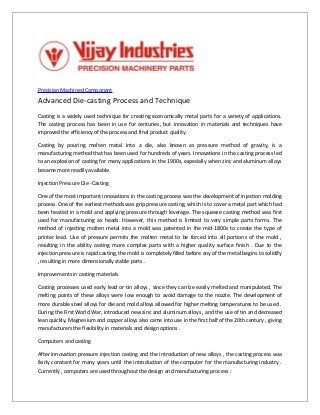
Advanced Die-casting Process and Technique
- 1. Precision Machined Component Advanced Die-casting Process and Technique Casting is a widely used technique for creating economically metal parts for a variety of applications. The casting process has been in use for centuries, but innovation in materials and techniques have improved the efficiency of the process and final product quality. Casting by pouring molten metal into a die, also known as pressure method of gravity, is a manufacturing method that has been used for hundreds of years. Innovations in the casting process led to an explosion of casting for many applications in the 1900s, especially when zinc and aluminum alloys became more readily available. Injection Pressure Die -Casting One of the most important innovations in the casting process was the development of injection molding process. One of the earliest methods was grip pressure casting, which is to cover a metal part which had been heated in a mold and applying pressure through leverage. The squeeze casting method was first used for manufacturing ax heads. However, this method is limited to very simple parts forms. The method of injecting molten metal into a mold was patented in the mid-1800s to create the type of printer lead. Use of pressure permits the molten metal to be forced into all portions of the mold , resulting in the ability casting more complex parts with a higher quality surface finish . Due to the injection pressure is rapid casting, the mold is completely filled before any of the metal begins to solidify , resulting in more dimensionally stable parts . Improvements in casting materials Casting processes used early lead or tin alloys , since they can be easily melted and manipulated. The melting points of these alloys were low enough to avoid damage to the nozzle. The development of more durable steel alloys for die and mold alloys allowed for higher melting temperatures to be used . During the First World War, introduced new zinc and aluminum alloys , and the use of tin and decreased lean quickly. Magnesium and copper alloys also came into use in the first half of the 20th century , giving manufacturers the flexibility in materials and design options . Computers and casting After innovation pressure injection casting and the introduction of new alloys , the casting process was fairly constant for many years until the introduction of the computer for the manufacturing industry . Currently , computers are used throughout the design and manufacturing process :
- 2. Mold Design - design of digital systems allow engineers to create and evaluate mold designs electronically , resulting in a smaller number of prototypes and design iterations . mold manufacturing - processes and advances in computerized manufacturing tools ( CAM ) allow very complex dies after being created with minimal human labor . Complex curvatures and intricate details can be machined in the mold with a CAM application driver. Process Automation - computer systems can control the casting process real and monitor the status of the workpiece during all portions of the manufacturing process. Systems can maintain correct pressures during casting to control the temperature of the molten metal and the mold after casting, cooling control part through water channels, and determining when the part is removed from the mold. Although the general concept of the casting has not changed significantly in the last few hundred years, advances in the process, materials and technology have allowed manufacturers to create more complex parts in a cost -effective. Vijay Industries is leading are Manufacturer, exporters and suppliers for CNC Turned Component and Cnc Machine Parts , Sand casting Component, Investment Casting Component, Pressure & Gravity Die Cast Component, Sub Assembly.